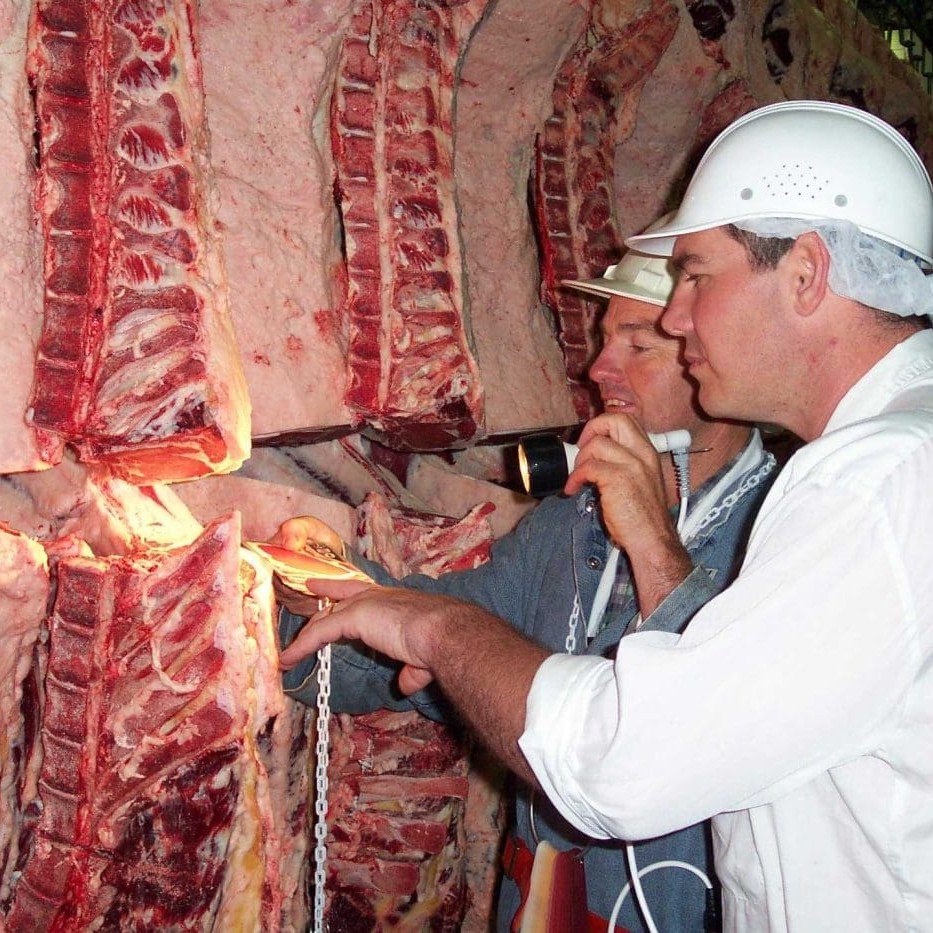Two millimetres. It isn’t much in carcase fatness measurement terms, but it represents a very significant shift in export processor thinking.
As of yesterday, both of Australia’s two largest beef processors will have direct consignment price grids that accept leaner grassfed export steers than they did previously.
 JBS Australia was the first to move, adjusting its price grid for grassfed ox after the Christmas/New Year seasonal closure. Previously the company’s plants required a minimum P8 fat depth of 7mm on export-weight grassfed steers in order to avoid price discounts, but as of January’s plant re-openings, that has reduced to 5mm.
JBS Australia was the first to move, adjusting its price grid for grassfed ox after the Christmas/New Year seasonal closure. Previously the company’s plants required a minimum P8 fat depth of 7mm on export-weight grassfed steers in order to avoid price discounts, but as of January’s plant re-openings, that has reduced to 5mm.
Teys Australia followed suit in new grids issued yesterday, with a similar (note: not identical) movement. Teys has pushed the lower limit in P8 fatness in its grids, in order to hit the pricing ‘sweet spot’, for four, six and eight-tooth heavy steer from 8mm to 6mm. The company’s milk and two-tooth and yearling grids already accepted fat tolerances down to 6mm.
JBS already had yearling and MSA cattle at a 5mm fatness minimum, meaning the changes made by both companies have now essentially ‘standardised’ the minimum fatness requirement across the full spectrum of grassfed steers.
Note that there is no change to cow fatness requirements on either company’s grid. In JBS’s case steers can still be discounted on the basis of insufficient cover over the butt/loins, however – even if the P8 measurement is 5mm or more.
The new fatness tolerances introduced by the nation’s two largest processors don’t sound much, but all other things being equal, it will reduce the number of grassfed slaughter cattle attracting grid penalties on insufficient cover.
A processor contact said cattle were obviously struggling to make fat requirements in the current drought season, and the number of price discounts based on insufficient fatness was obvious a lot higher this year than what it was back in 2012, for example.
What's behind it?
It appears there is a basket of reasons behind the grid changes – some simple, others more complex.
Firstly, let’s clear up a couple of misnomers. The adjustment has nothing to do with either company ‘lowering its standards’ at a time when adequately finished cattle are harder to come by, due to the drought.
Instead the adjustments are permanent, and squarely market-driven.
The simple fact is that Australian exporters are now much less reliant on the Japanese market than they once were. The old fatness tolerances for grassfed ‘Jap ox’ that were set up 25-odd years ago were squarely aligned with Japanese customer requirements, one major processor said yesterday.
“They wanted considerable selvedge along the striploins and other cuts, for example, so it very much dictated the carcase fatness minimum requirement set by processors,” one company’s livestock manager told Beef Central.
“Today, markets are changing, and more heavy grassfed beef is finding its way into markets other than Japan. The typical consumer in an export market for grassfed beef today wants a little external fat, but not excessive,” he said.
China and other markets now representing a much bigger slice of the grassfed ox pie. Even in the past 12 months, for example, Japan’s share of Australia’s global beef trade has slipped from 32pc to 26pc in 2013.
Move won’t compromise eating quality
 The grid changes will not compromise eating quality in any way, a leading meat scientist told Beef Central.
The grid changes will not compromise eating quality in any way, a leading meat scientist told Beef Central.
MLA’s manager, eating quality R&D, Dr Alex Ball said exhaustive MSA research had set a minimum boundary of 3mm fat at the rib site to achieve consistent eating quality outcomes, and the criteria applied as much to heavier export bodies as it did to more typical lighter MSA ones.
Dr Ball offered a number of other observations about the grid changes.
“The move would also appear to reflect the improvements and heavy investment in chilling technology made by processors, with innovations like spray chilling, which means they no longer run the same risks with chiller-burn on leaner carcases as they did previously,” he said.
“There’s also an industry productivity factor here. Every kilogram of fat laid down by a beast requires 34 megajoules of energy to produce, whether it be through grass, silage, supplement or grain. A kilogram of meat, on the other hand, requires just 5 megajoules of energy to produce. So by reducing unnecessary fatness in carcases, based on today’s consumer preferences, it can present an industry efficiency saving,” Dr Ball said.
While it was difficult to quantify, he thought a 2mm adjustment in minimum fat requirement might lift the number of carcases qualifying for the grassfed ox top-sell by 3-4pc.
“Less discounts on fatness has to be a good thing for producers,” Dr Ball said.
He also suggested there would be a small carcase yield benefit to processors through admitting leaner carcases, although this was unlikely to be a motivating factor for the change.
One suggestion has been that some producers might ‘take a risk’ on consigning leaner cattle under the new regime, hoping to ‘sneak them through’ just above the new 5mm/6mm limits.
“Only a portion are drafting cattle in trying to hit a narrow fatness range," a processor said.
"If the season’s good they’re going to have 15-16mm of fat; if the season’s not so good, it might be 10mm; or if the season’s bad as it is this year, they might average 5 or 6mm. That could still mean half might hit the fatness grid spec, and half not, but I can’t see people sending cattle earlier, just because there is more tolerance now on fatness. Nobody is that good at picking fat cover.”
With the ‘default’ US ox market being as strong as it is at present, the fatness issue may be less significant, in terms of price penalties, for the timebeing. One grid seen this week had steers carrying 3-4mm fat being 20c/kg off the top grid offer, for the same steers carrying 5mm or more fat.
